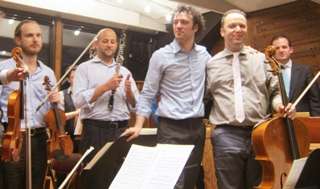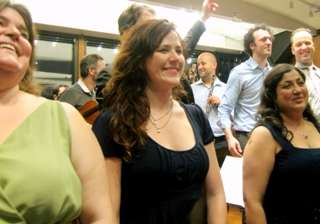|
Back
The Intimate Baroque Experience New York
BargeMusic
06/15/2013 - & June 16, 2013
Masterworks Series
Johann Sebastian Bach: Cantata “Weinen, Klagen, Sorgen, Zagen”, BWV 12 – Cantata “Wachet! Betet! Wachet! Betet!, BWV 70
Arvo Pärt: Magnificat
György Kurtág: Selections from Jelek, játékok és üzenetek
Clarion Ensemble: Sherezade Panthaki, Molly Quinn (Sopranos), Luthien Brackett, Timothy Parsons (Altos), David Vanderwal, Marc Day (Tenors), Dashon Burton, Scott Dispensa (Basses), Stephen Fox (Artistic Director)
The Knights: Colin Jacobsen, Guillaume Pirard (Violins), Nicholas Cords, Max Mandel (Violas), Alex Greenbaum (Cello), Zach Cohen (Bass), Adam Hollander (Oboe), Josh Frank (Trumpet), David Enlow (Organ), Eric Jacobsen (Conductor)

G. Pirard, A. Hollander, E. Jacobsen, A. Greenbaum, D. Enlow
(© Coco T. Dog)
To quote that Brooklyn-bravura keyboard-tickler profundo, Jimmy Durante, “Everybody wants ta get inta de act.” At BargeMusic last night (with a repeat this afternoon), the alleged choral/orchestral performance of J.S. Bach was a misnomer. Everybody was a soloist, and everybody–even the audience–got into the act.
One imagines Bach would have been well content with the forces here. Clarion Ensemble had two singers for each voice, not the magniloquent forces used in New York for church cantatas. He would have certainly approved the Bach sized orchestra of nine players and a conductor. Then again, the stage of BargeMusic with its background of New York going from twilight to darkness, while beautiful, is not exactly spacious, and even these small forces could barely fit.
He certainly would have been content with the obvious good cheer and friendship shown by both groups. When J. S. took over a church, the players were all old friends, and one doubts that Germanic stolidity would have disrupted the communion of lager-drinking landsmen coming together for a Sunday of music playing, followed no doubt by merriment with the infinite Bach children. (He was one of history’s most productive composers.) The Knights, which started with late-night classical/jazz jam sessions, reflected that brotherly respect and amiability.
The cantatas were exuberantly performed, though one wouldn’t have guessed it from the opening Sinfonia of Weinen, Klagen, Sorgen, Zagen, a mournful oboe concerto played by Adam Hollander. The titular chorus, sung by each of the voices in turn, the four groups placed around the orchestra instead of one section, was like a fugue of sighs, gentle, despairing. The one alto was countertenor Timothy Parsons, whose solo was splendid. The end brought out the piccolo trumpet of Josh Frank, I believe the only Baroque instrument.
Other instrumentalists of note included cellist Alex Greenbaum, who had multiple functions. First, as soloist, then as ensemble cellist and third as continuo player with organist David Enlow and (sometimes) bass player Josh Cohen. But the entire string section played with measures that seemed spontaneous, just as Bach wanted in these dramatic cantatas.
In fact, for those who find Bach the dry “mathematician-organist”, the first recitative of the following cantata showed a merciless picture of terror. The ensemble semi-quavers, the trembling strings, the furioso of baritone Dashon Burton’s aria about the Last Judgment would have made Berlioz shake with excitement. (“Why couldn’t I have thought of something like that in my Dies Irae?”)
Yet with all this, the two ensembles showed a communal spirit, a feeling that these were friends having a good time in re-enacting the liturgy from the Age of Belief.

L. Brackett, M. Quinn, S. Panthaki (© Coco T. Dog)
This was not an all-Bach program. Arvo Pärt’s magnificent six-minute Magnificat was performed immediately after the first cantata, again with a different view (or ear) point. Previously when listening to the Magnificat in venues like Avery Fisher Hall with a large chorus, the work gave the aura of a Byzantine apse, with auras of censers, of blackness and dim tapers, the voices coming out of a dank wilderness.
Here, the eight singers with some sensitive solos by Molly Quinn, showed Arvo Pärt’s carefully woven skein of tonal colors. Instead of those close harmonies as mysteries, the minor seconds glowed, the tonal clusters gave a soft glow.
Following that, the five selections from György Kurtág’s Signs, Games and Messages actually did seem mysterious. Arranged for string quartet–with the second violin hidden in the back of the auditorium–Kurtag’s kernels, both fast and slow, were less bagatelles than tiny jewels which glowed their crepuscular light and quickly faded away.

S. Fox (© Coco T. Dog)
At the top, I mentioned that even the BargeMusic audience got “inta de act”. That wouldn’t have surprised J.S. Bach. He expected church congregations to know their chorales, and were ready to sing along for the finales, just as churches these days sing hymns together. While parishioners in Leipzig’s St. Thomas Church wouldn’t have had to be coached, conductor Stuart Fox did work with a one-stave sheet of music, and we all joined in (sort of) for our lackadaisical version of Bach’s seven-voice finale.
Well...we tried. Clarion and Knights, though, knew just what they were doing.
Harry Rolnick
|